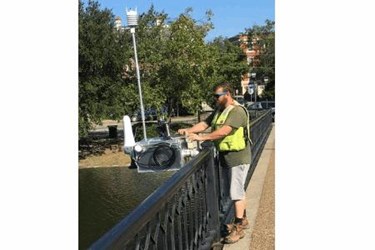USGS Tidal Network Monitoring Elevated Water Levels Off Hampton Roads

To learn more about USGS’ role providing science to decision makers before, during and after Hurricane Jose, visit the USGS Hurricane Jose page at https://www.usgs.gov/jose.
A network of 23 U.S. Geological Survey tide gauges installed throughout Hampton Roads and along the Eastern Shore of Virginia is monitoring elevated water levels caused by Post-Tropical Cyclone Jose.
Even though Jose never made a direct impact on the United States, it generated large waves along it’s entire path and coastal effects have been felt from Florida to New England and the flood prone Hampton Roads region in Virginia is no exception. As Jose churned in the Atlantic it pushed water from the mouth of the Chesapeake Bay into the heavily populated Hampton Roads harbor, raising water up to two feet in some places, causing some minor flooding around the Hauge inlet in Norfolk, Virginia.
The water levels have started declining and are expected to continue to fall over the next few days as Jose continues to weaken, but it is possible Hurricane Maria could drive levels up again as it passes off the coast early next week.
The tide gauges in the network, which span across almost a dozen cities and counties in the area, measures continuous water levels every six minutes in areas where land subsidence – the gradual caving in or sinking of land – and sea level rise are contributing to more frequent nuisance flooding.
The data is helpful to emergency management, storm water, and public works departments across the region as well as to landowners and business owners who own property near the many water bodies in the area. In conjunction with publicly available applications such as WaterAlert – where the public can sign up to receive notifications of rising water in their area – these gauges can provide up-to-date information around the clock about water levels, rainfall amounts, and wind speed and direction.
“City officials can use this data to make emergency decisions during a storm, such as when to close roads and issue evacuation orders,” said Russ Lotspeich, USGS Hydrologist. “These gauges give emergency managers and our cooperators the ability to make important decisions in real time and the long term benefits provide them with more data that can be used to assess coastal changes and monitor sea level rise.”
This tide gauge network has been actively collecting tide elevation data since the first gauge was installed on the Severn River in January, 2015. The project is funded by numerous city, county, municipal and federal cooperators in the area.
While these tide gauges provide valuable data to several jurisdictions in the Hampton Roads area, others will benefit from the information as well, which is available on the USGS National Water Information System webpage.
The water level and meteorological data these gauges collect is also used by the National Weather Service to assist with their flood warnings. Boaters, fishermen and others heading to the beach will also find the information of use to determine conditions before they head to the shore.
For more than 125 years, the USGS has monitored flow in selected streams, rivers and coastlines across the United States and does so in cooperation with over 850 federal, state and local agencies.
Source: U.S. Geological Survey
